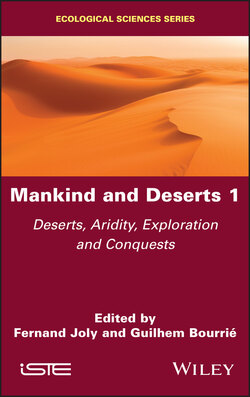Читать книгу Mankind and Deserts 1 - Группа авторов - Страница 13
1.5. To know more
ОглавлениеBirot, P. (1970). Les régions naturelles du globe. Paris: Masson.
Chenu, R. (1997). Le désert — Petite anthologie. Paris: CERF, 129 p.
CRISM, ed. (2000). Figures — Le désert. Cahiers du Centre de Recherches sur l’Image, le Symbole et le Mythe, Université de Dijon, 167 p.
Cuny, H. (1961). Les déserts dans le monde. Paris: Payot.
Demangeot, J. and Bernus E. (2001). Les milieux désertiques. Paris: Armand Colin. Doucey, B., ed. (2006). Le livre des déserts. Collection Bouquins. Paris: Robert Laffont, 1231 p.
Dresch, J. (1966). “La zone aride, Géographie générale.” In Encyclopédie de la Pléiade. Paris: Gallimard, pp. 712–780.
— (1982). Géographie des régions arides. Collection Le Géographe. Paris: Presses Universitaires de France. 277 pp.
Haudricourt, A. and Hédin L. (1943). L’homme et les plantes cultivées. Géographie humaine. Paris: Gallimard. 233 pp.
Hills, E.S., ed. (1966). Arid lands, a geographical appraisal. Paris, London, UNESCO, Methuen & Co. 461 pp.
Joly, F. (1957). “Les milieux arides— Définition— Extension.” In Notes marocaines, Rabat 8, pp. 15–30.
Mc Ginnies, W., Goldman, B. and Paylore P. (1968). Deserts of the world — An appraisal of research into their physical and biological environments. University of Arizona Press. 788 pp.
Meigs, P., ed. (1977–1979). Carte de la répartition mondiale des régions arides, Carte à 1/25 000 000, 1 feuille en couleurs, Notice explicative. Notes techniques Man and Biosphere 7. Paris: UNESCO. 55 pp.
Monod, T. (1937). Méharées. Explorations au vrai Sahara. Bibliothèque des voyages. Paris: Je sers. 300 pp.
— (1973). Les déserts. Paris: Horizons de France.
Petit-Maire, N. (1984). “Le Sahara, de la steppe au désert.” In La Recherche 160, pp. 1372–1382.
Petrov, M. (1976). Deserts of the world, New York: John Wiley & Sons Ltd. de Planhol, X. and Rognon , P. (1970). Les zones tropicales arides et subtropicales.
Paris: Armand Colin. 487 pp.
Pouquet, J. (1951). Les déserts. Que-sais-je ? 500. Paris: Presses Universitaires de France.
Sorre, M. (1943). Les fondements biologiques de la géographie humaine — Essai d’une écologie de l’homme. Paris: Armand Colin.
UNESCO, ed. (1962). Les problèmes de la zone aride — Actes du colloque de Paris. — ed. (1995). Les zones arides dans les programmes de l’UNESCO. Paris: UNESCO.
Chapter written by Fernand JOLY.
1 1 Editor’s note: The Port-Royal-des-Champs Convent, south of Paris, was, in the mid-17th Century, home to a strict and ascetic religious order (Jansenism) whose teaching focused on Original Sin and condemned involvement in any “worldly” activity.
2 2 Translator’s note: In French, desert is also used for “wilderness”.
3 3 Editor’s note: Fénelon, a 17th Century archbishop of Cambrai – a city in the north of France – was renowned for his eloquence. He was a champion of women’s education, an uncommon stance in those times.
4 4 The term “exorheic” describes a river that drains into the sea or another water body.
5 5 The term “endorheic” signifies that a body of water terminates in a closed depression.
6 6 The term “arheic” describes a temporary body of water with no surface runoff at all.
7 7 A “glacis” is a plane or slightly concave surface, with a small slope that is less than 10°, at the foot of a steep slope.
8 8 An “inselberg” is an isolated hill or mountain rising abruptly from an erosion plane.
9 9 Endemism is used to describe species that are unique to a particular region.
10 10 The term “eremic” means pertaining to deserts, from the Greek ἔρημος (érèmos) = desert, solitary.
